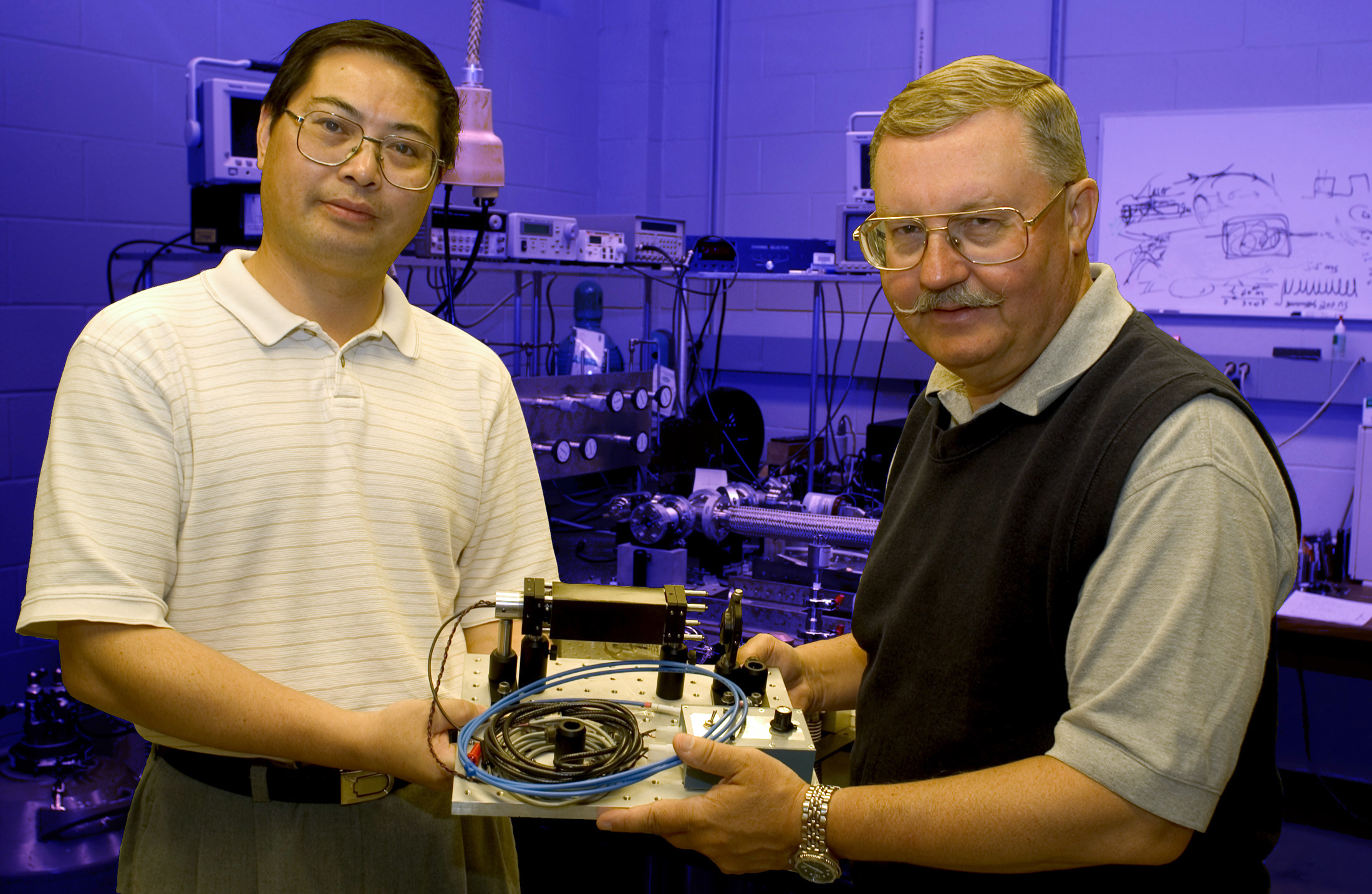Contact: Phil Hearn

Chuji Wang (left) and John Plodinek
Two Mississippi State scientists have invented a high-tech sensory device that can detect the early symptoms of diabetes in a person's breath.
John Plodinec and Chuji Wang already have developed a prototype and applied for a patent. They now are seeking a commercial partner to help them move their unique diabetes breath analyzer from the university laboratory into the marketplace.
"You blow your breath into the instrument one time and you receive a number indicating your status, whether you are diabetes-free or in the early or severe stages of the disease," said Wang, a physicist and native of China. "Potentially, in the future, you could install one of these devices in a mall."
Plodinec pointed out that in addition to detecting new cases of diabetes, the breathalyzer might be used to flag the ineffective treatment of known patients or serve as a breath marker for other diseases.
"There is no reason we can't develop similar monitors for many other conditions ranging from cancer to the flu and the common cold," said Plodinec, director of the university's Diagnostic Instrumentation and Analysis Laboratory.
Established in 1980, the MSU laboratory-usually referred to as DIAL-is a research unit in the Bagley College of Engineering. Wang is an assistant research professor at the lab, which is a national leader in the development of monitoring, testing and control techniques to solve energy, environmental, infrastructure, and industrial problems.
Of some 17 million Americans who suffer from diabetes, health officials report nearly six million are unaware they have the disease. Obesity is a leading contributor to the development of diabetes, and state Health Department statistics confirm more Mississippians are overweight and diabetic now than ever before. Mississippi leads the nation in the incidence of diabetes and in the adult onset diseases associated with diabetes, such as blindness.
In the past, urine sugar tests and fasting blood tests have been used as primary methods of screening for diabetes. Low in sensitivity, however, the tests often give negative results to those who have early diabetes. The glucose tolerance test is more accurate for diabetes diagnosis, but can be painful and troublesome. Blood hemoglobin and fructosamine tests are considered unreliable in the case of light diabetes.
The breath analyzer developed by Plodinec and Wang utilizes Cavity Ring-Down Spectroscopy (CRDS) to detect concentration levels of acetone in a person's breath gas. The level of acetone in one's breath can indicate whether that person has diabetes.
"The main advantage is a fast response and it's non-invasive," said Wang, who completed post-doctoral work at the University of New York at Syracuse from 1998-2000 after receiving a doctorate in chemical physics from the University of Science and Technology of China.
"It's better to diagnose diabetes in the early stages, which requires a very sensitive instrument," he added. "People who have diabetes have acetone breath. We can use this instrument to detect the acetone."
Continuous Wave Cavity Ring-Down Spectroscopy was developed by Princeton University and commercialized by Tiger Optics to detect a wide range of gaseous contaminants, disease indicators and environmental pollutants. It works by attuning light rays to a given species and then, in microseconds, measuring the time required for the light to fade or "ring down." The time of light provides an exact, non-invasive and rapid means of detecting contaminants, even in breath.
Utilizing reflective mirrors to enhance laser paths and detection sensitivity, Tiger Optics applies the technology for a variety of private and public uses-including environmental monitoring, homeland security and detecting coatings moisture in the manufacture of semiconductor chips. But Wang, who worked for the Warrington, Pa.-based firm before joining MSU in July 2002, said it was Plodinec who suggested CRDS' possible medical applications during discussions at DIAL last fall.
"I thought that cavity ring-down might be the right answer (for diabetes detection) because of its compactness, its sensitivity and its simplicity," said Plodinec. "Chuji Wang picked up on that and demonstrated feasibility."
The two researchers achieved proof of concept, designed a prototype in early 2004 and applied for a patent with the U.S. Patent Office, initiating a process that usually takes from 12 to 18 months for a decision. Part of the research will be published in July as a scientific paper in Applied Spectroscopy, the professional journal of the Society for Applied Spectroscopy.
In the meantime, they will seek assistance from medical experts to conduct tests on human subjects and explore commercialization possibilities for their invention. The expected cost range is $5,000 to $15,000 per unit at commercial volumes.
Plodinec envisions the day when a small monitoring device can be mounted over a home-bound diabetes patient's bed, recording medical data for telemetering back to a central service or to the patient's physician.
"We're years away from that, but the promise of a device that will provide the doctor with solid information for rich and poor, old and young, educated and unschooled alike, is both real and exciting," the scientist said.
For more information, telephone Plodinec or Wang at (662) 325-2105.